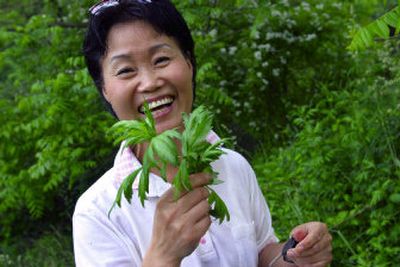Koreans pluck mugwort

WASHINGTON – Koreans see the feathery green plant everywhere in the Washington metro area. Souk adds a bitter sharpness to seafood soup and a green tint to rice cakes. Applied to the skin, it is said to ease pain.
Nam Sun-lee arrived in Montgomery County, Md., from South Korea in 1977 and soon discovered that souk prospers here, too. “It was so exciting,” she said. She has plucked sprigs of the plant from a county park near her home for decades. The flavor helps her remember where she grew up.
The people who run the parks call the plant by its common English name, mugwort. To them it is a weed, something they wish would go away.
The story of mugwort in Montgomery is a reminder that some people reap what others mow. It is also a tale of gently clashing cultures. Parks officials are wondering how best to inform collectors of souk that removing things from county property is illegal.
“We’re making sure we’re doing this in a sensitive, low-key kind of way,” says Shu-Ping Chan, the Asian Pacific American liaison for the county.
For the past two springs, park naturalist Leslie Sturges has found elderly Asians harvesting mugwort from parts of Cabin John Regional Park in North Bethesda, Md. She has tried to inform them of the rules forbidding the removal of flora. “The language barrier, especially in old folks, is pretty formidable,” she says. “They don’t understand me, and I don’t understand them.”
Some of the harvesters have told her the plant is used for medicine. Others have mentioned soup, but the conversations never go far. Sometimes a harvester will fill up two or three plastic shopping bags with the leaves. One left behind a Ginsu 2000 knife, its serrated edge flecked with green.
County officials held a mugwort meeting in May to discuss how “to educate people about some of the park regulations,” said Alexandra Teaff, multicultural community outreach manager for the Maryland-National Capital Park and Planning Commission. The effort might include signs in an Asian language, she said.
The officials see mugwort in the context of their struggle against a variety of non-native plants that are taking over parkland. Some of the chief villains are multiflora rose, kudzu and garlic mustard; mugwort is small-time by comparison.
For years, the commission has trained volunteers to rid the parks of unwanted flora, and this week, it has embarked on a pilot program to see whether goats can do the same.
Montgomery officials seeking a solution might draw inspiration from Patapsco Valley State Park in Elkridge, Md., which has hosted an annual “Garlic Mustard Challenge” since 2000. Visitors are invited to pull up as much of the invasive weed as they can. Amateur and professional chefs then have a garlic mustard cooking contest.
Patapsco, which is run by the Maryland Department of Natural Resources, maintains rules similar to Montgomery’s forbidding the removal of things from the park. “Unless it’s approved,” noted assistant park manager Bruce Wilkins. “Everything’s not always black and white.”
Koreans have a tradition of foraging for greens and herbs. “Harvesting stuff from a city park would seem very normal in Korea,” said Steven K. Roney, a Canadian teacher of English who lived in Seoul, South Korea, for much of the 1990s and who wrote newspaper columns on mugwort and other aspects of Korean culture.
Roney concocted his own souk pesto, which features mugwort in the place of basil. The result is “just not quite bitter enough to be unpleasant,” he said.